Have you learnt the way to measure flour appropriately? In the event you’re the slightest bit unsure, this tutorial is for you! To be clear, one of the simplest ways to measure flour is with a scale, however not all Amerians personal a scale.
The second-best methodology is “spooned and leveled.” The entire recipes on this weblog use this methodology, so I wish to share precisely what which means at this time.
In case your baked items don’t all the time end up like the images, your measurements may be off. Let’s repair that. With this methodology, your cookies, muffins, and pizza dough will end up persistently from batch to batch.


Why does your measuring methodology matter?
Truth: While you weigh your flour on a scale, you’ll all the time find yourself with precisely the identical quantity. Baking is a science, so this stage of consistency is good.
While you measure flour by the cup utilizing the spoon-and-level methodology, the measurements will fluctuate by just a few grams, which is shut sufficient to yield constant outcomes from batch to batch.
Nonetheless, the measurements can fluctuate considerably should you measure flour by the cup utilizing different strategies, and the recipe wasn’t designed for that methodology. In the event you scoop the flour straight into the cups fairly than spooning and leveling the flour, you possibly can find yourself with 25 % extra flour.
That’s loads of additional flour. It’s going to throw off the feel of your baked good, making it dry and dense. It’s going to affect the baking time, requiring extra time within the oven to cook dinner by and switch golden on prime. The end result will style much less flavorful.
Backside line? Measurements matter!


Tips on how to Measure Flour Utilizing the Spoon-and-Degree Methodology
Measuring flour is simple when you understand how.
- Stir the flour with a big spoon. If it’s been sitting in your pantry for some time, the flour has settled, and we have to fluff it up slightly.
- Working over the container of flour, gently spoon massive spoonfuls of flour into your measuring cup till the cup is calmly overflowing. Don’t faucet the cup to settle the flour.
- Degree throughout the highest with the flat aspect of a butter knife. Let the additional flour fall again into the container. Repeat as essential.
Watch Tips on how to Measure Flour
Different Measuring Strategies
Despite the fact that that is my most well-liked methodology for measuring flour (and King Arthur Flour, Bob’s Red Mill, Sally McKenney and Stella Parks agree), different recipes are designed for different measuring strategies.
Some recipe builders like Alison Roman and America’s Test Kitchen use the dip-and-sweep methodology (scoop the flour straight into the cups and stage off the highest).
That’s why it’s important to find out every recipe supply’s most well-liked measuring methodology earlier than you get began. If measurements are supplied in grams, you’ll be able to bypass the difficulty through the use of a scale.


Widespread Flours by Weight
Listed here are the commonest flours I take advantage of in my recipes.
- All-purpose flour: 122 grams per cup (typical vary is 120 to 125 grams)
- Entire wheat flour, together with white complete wheat flour: 122 grams per cup (typical vary is 120 to 125 grams)
- Entire wheat pastry flour: 115 grams per cup (typical vary is 110 to 120 grams)
- Oat flour: 88 grams per cup (typical vary is 85 to 91 grams)
- Almond flour: 92 grams per cup (typical vary is 85 to 100 grams)
Baked Items to Take pleasure in
Now that you understand how to measure flour appropriately, let’s activate the oven and begin baking. Listed here are just a few of my favourite recipes:
Please let me know what you assume within the feedback! I like listening to from you.


